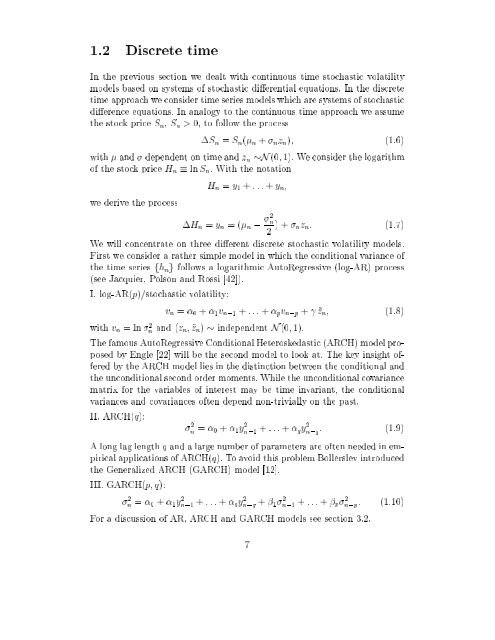Estimation in Financial Models - RiskLab
Estimation in Financial Models - RiskLab
Estimation in Financial Models - RiskLab
Create successful ePaper yourself
Turn your PDF publications into a flip-book with our unique Google optimized e-Paper software.
1.2 Discrete time<br />
In the previous section we dealt with cont<strong>in</strong>uous time stochastic volatility<br />
models based on systems of stochastic dierential equations. In the discrete<br />
time approach we consider time series models which are systems of stochastic<br />
dierence equations. In analogy to the cont<strong>in</strong>uous time approach we assume<br />
the stock price S n , S n > 0, to follow the process<br />
S n = S n ( n + n z n ); (1.6)<br />
with and dependent on time and z n N (0; 1). We consider the logarithm<br />
of the stock price H n ln S n . With the notation<br />
we derive the process<br />
H n = y 1 + :::+ y n ;<br />
H n = y n =( n , 2 n<br />
2 )+ nz n : (1.7)<br />
We will concentrate on three dierent discrete stochastic volatility models.<br />
First we consider a rather simple model <strong>in</strong> which the conditional variance of<br />
the time series fh n g follows a logarithmic AutoRegressive (log-AR) process<br />
(see Jacquier, Polson and Rossi [42]).<br />
I. log-AR(p)/stochastic volatility:<br />
v n = 0 + 1 v n,1 + :::+ p v n,p + ~z n ; (1.8)<br />
with v n =ln 2 n and (z n ; ~z n ) <strong>in</strong>dependent N (0; 1).<br />
The famous AutoRegressive Conditional Heteroskedastic (ARCH) model proposed<br />
by Engle [22] will be the second model to look at. The key <strong>in</strong>sight offered<br />
by the ARCH model lies <strong>in</strong> the dist<strong>in</strong>ction between the conditional and<br />
the unconditional second order moments. While the unconditional covariance<br />
matrix for the variables of <strong>in</strong>terest may be time <strong>in</strong>variant, the conditional<br />
variances and covariances often depend non-trivially on the past.<br />
II. ARCH(q):<br />
2 n = 0 + 1 y 2 n,1 + :::+ qy 2 n,q : (1.9)<br />
A long lag length q and a large number of parameters are often needed <strong>in</strong> empirical<br />
applications of ARCH(q). To avoid this problem Bollerslev <strong>in</strong>troduced<br />
the Generalized ARCH (GARCH) model [12].<br />
III. GARCH(p; q):<br />
2 n = 0 + 1 y 2 n,1<br />
+ :::+ q y 2 n,q + 1 2 n,1<br />
+ :::+ p 2 n,p: (1.10)<br />
For a discussion of AR, ARCH and GARCH models see section 3.2.<br />
7
















